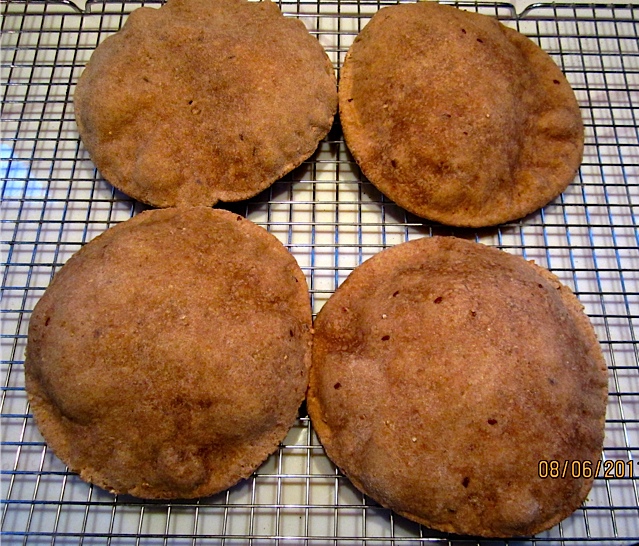Rummaging through my basement refrigerator, I rediscovered a ziplock bag of whole grain pita dough pieces (my variation of P.R.'s recipe in WGB). I had frozen those 9 months ago (after bulk fermenting and shaping them into balls), wrapped separately in plastic. They were covered with some snow, and their surface looked darker.
Before throwing them away, I wanted to give them a chance - and find out whether there was any life left after all that time. I placed them in a warm spot in the kitchen, and, while baking my usual breads for sale, checked now and then on them. After 3 hours nothing had changed. Again I was tempted to end their misery, but decided to wait a little longer.
Fife hours passed - it appeared as if the dough balls had grown a tiny bit. Six hours, seven, eight - very slowly more growth. After ten hours the rolls had about the size they normally have 60 minutes after taking them out of their overnight stay in the fridge. I rolled them out, they were now as elastic as fresh ones, but their surface was darker, and somewhat mottled.
In the oven the defrosted pitas did not swell with a few large bubbles that merge before poofing like a ballon. Instead they showed many smaller bubbles that didn't quite join into one large gas pocket.They didn't look as nice as fresh ones, but otherwise performed well enough.
All in all, it seems that if you don't give up, and are patient enough to wait, the surviving frost resistant yeast cells are still able to do their job, though veeeeeerrrry slowly.
Karin

Whole wheat pitas made from fresh dough - with a rather smooth surface and uniform looks.

Multigrain Pitas from long time frozen dough - uneven surface and coloring, but the surviving (instant) yeast cells had still enough leavening power to rise sufficiently.
I admire your patience Karin. I'm sure I would have tossed it after 4-5 hrs, but isn't it amazing just how resilient these little yeast cells are. I'm curious though as to how the pita tasted.
Franko
We had to leave town for a few days, so I froze those pitas (again). But whenever some of the pitas I bake for sale are misshapen or had another baking accident, we'll have them, with Halloumi and tomato. The multigrain/whole wheat ones taste especially nice. I will report when we ate them.
Karin
You indeed have rescued them from their misery, in a nice way, Karin! Lovely..
You now officially urge me to bake Wholewheat pitas from PR's wholegrain breads! After all, i'am from lebanon, our staple bread being Pita; though i found baking pitas to be tidious and require extended bench space, continuous attention, and having to put up with an untidy kitchen for longer than i can endure!
Khalid, I bake them every week, so I figured out how to do it rather efficiently. They are not like those white ones we often buy in an Iraki cafe (using them as pizza crust) that have a much softer dough and are hand stretched - probably more like what you have as staples in Lebanon. Those are nice, but don't have too much taste by themselves. Whole wheat or multigrain pitas (I substitute 57 g of whole wheat in the soaker with a 7-grain mix) have a really good taste.
I make the soaker and biga in the morning before the baking day, mix the dough in the evening, divide it in two parts (easier to divide it into 8 pieces later), and refrigerate the dough overnight. Pitas go into the 550 F hot oven, so I bake them last after all my other breads, placing the (baking stone lined) rack in the second highest position in my regular oven, and alternating between "broil" and "bake" for preheating the oven.
I remove the dough from the fridge only 1 hour before baking, shape them cold into rolls (they don't take long to warm up), let them rise and roll them out first to 10 cm rounds, then to 16 - 18 cm diameter. I always bake two at a time (more is difficult for me to control), they poof very fast, you have to watch closely. But the whole batch is baked rather quickly, in between loading the pitas in the oven I switch to "broil" again, to get the heat up fast enough.
Those pitas are a great lunch favorite in the natural food store that sells my breads, if some are not sold, the employees eat them. This is, by the way, one of the few Peter Reinhart recipes, where I do not reduce the amount of sweetener, the whole wheat really needs the honey.
So, even with all those nice white pitas around, you should give these a try, they are really different.
Karin
Thanks for the Tips, Karin. I'll have to try them someday... I have been working on some newly bought affrodable Premium White flour, and testing indicates good results so far.
Here follows the conclusion to my frozen pita dough revival: we had them for lunch with fried Halloumi and tomatoes, and they tasted almost as good as their fresh brethren.
Therefore, even though I would not recommend freezing bulk risen and pre-shaped pita dough for so many month, if you unearth some long forgotten ones from your freezer - these "Ötzis" do come to life again, and even do still taste good.
Karin